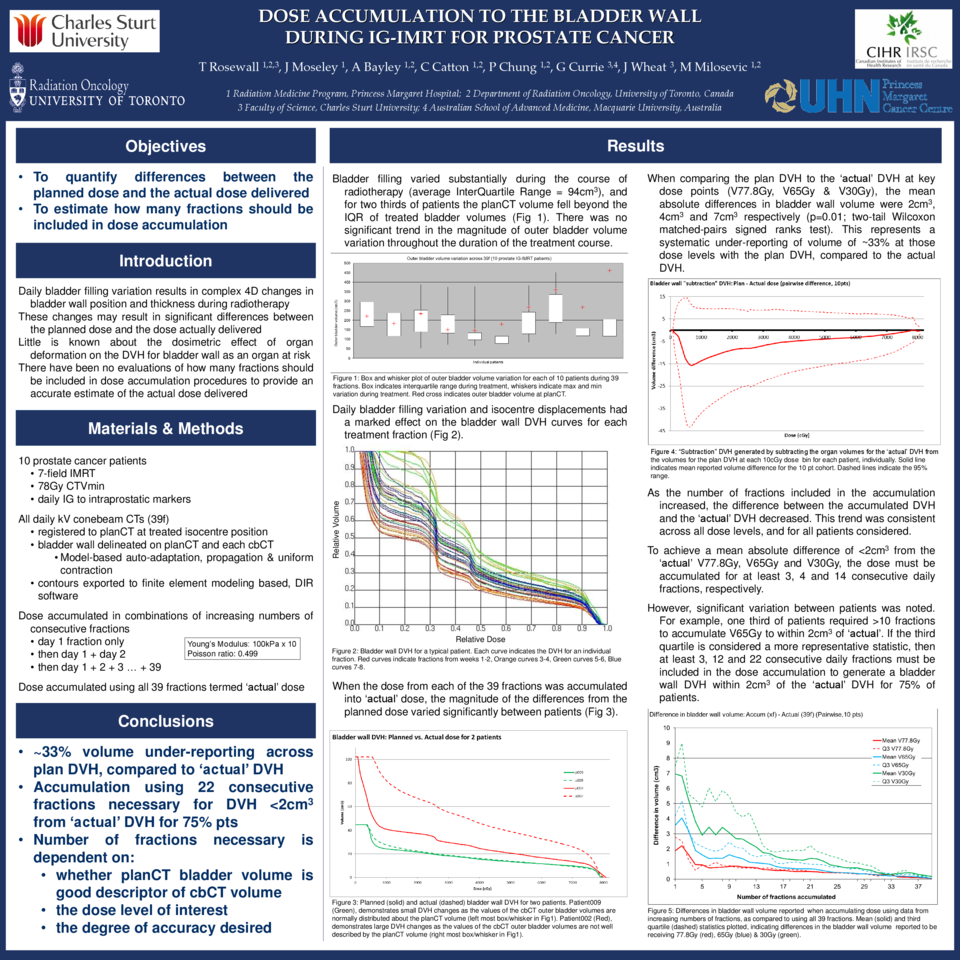Abstract
T Rosewall, J Moseley, A Bayley, C Catton, P Chung, G Currie, J Wheat, M Milosevic
Bladder filling variation results in complex 4D changes in bladder wall position and thickness between daily radiotherapy fractions. These changes may result in significant differences between the planned dose and the dose actually delivered, particularly for treatment plans that exhibit sharp dose gradients. The purpose of this research was to quantify the differences between the planned dose and the actual dose delivered to the bladder wall during IG-IMRT for prostate cancer, and to determine how many consecutive fractions should be included in dose accumulation procedures.
Ten consecutive prostate cancer patients were identified, who had completed a course of IG-IMRT (78Gy in 39 fractions). The 39 daily kV conebeam CTs (cbCT) were registered to each planCT at the treated isocentre position. The bladder wall was delineated on the planCT and each cbCT using model-based auto-adaptation and propagation techniques. These contours were exported to finite element modeling based, deformable registration software. The dose to the bladder wall was then accumulated using increasing numbers of consecutive fractions. The dose accumulated using all 39 fractions was defined as the “Actual” dose delivered.
Bladder filling varied substantially during the course of radiotherapy (average InterQuartile Range=94cm3), and for two thirds of patients the planCT volume fell beyond the IQR of treated bladder volumes. When comparing the planCT DVH to the Actual DVH, the mean absolute differences in the bladder wall V77.8Gy, V65Gy and V30Gy were 2cm3, 4cm3 and 9cm3 respectively (p=0.05; two-tail Wilcoxon matched-pairs signed ranks). These correspond to differences of 36%, 21% and 21% from the absolute volumes reported in the Actual DVH. To achieve a mean difference of <2cm3 from the Actual bladder wall V77.8Gy, V65Gy and V30Gy, it was necessary to accumulate dose over at least 3, 5 and 15 fractions, respectively. This trend was consistent across dose levels, but significant variation between patients was noted. For example, one third of patients required >10 fractions to accumulate V65Gy to within 2cm3 of Actual.
The planCT DVH does not provide an accurate estimate of the dose actually delivered to the bladder wall during prostate IG-IMRT. For a more accurate estimate of Actual bladder wall dose it is necessary to accumulate daily doses over weeks 1–3. Fewer accumulated fractions are necessary for an accurate estimate of the high dose portion of the Actual DVH, compared to lower doses. However, marked unpredictable variation between patients suggests that whole course dose accumulation is currently necessary if an accurate estimate of the Actual bladder wall dose is required.





